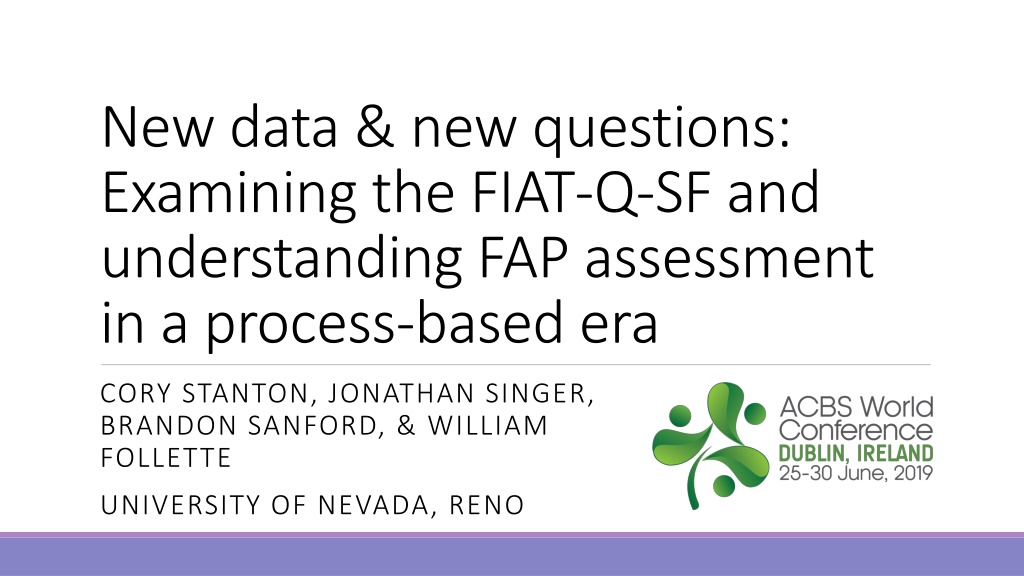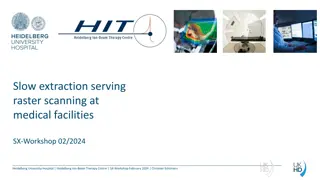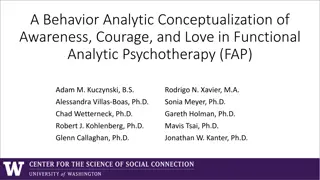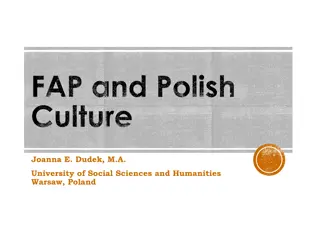Understanding FIAT-Q-SF and FAP Assessment in Process-Based Therapy Era
Delve into the analysis of FIAT-Q-SF and Functional Analytic Psychotherapy (FAP) with a focus on process-based therapy approaches. Explore the unit of analysis in FAP, emphasizing the contextual behavioral aspects and the use of reinforcement for behavioral improvements. Gain insights into the FIAT system, contingent responding in therapeutic relationships, and the idiographic assessment template system.
Download Presentation

Please find below an Image/Link to download the presentation.
The content on the website is provided AS IS for your information and personal use only. It may not be sold, licensed, or shared on other websites without obtaining consent from the author. Download presentation by click this link. If you encounter any issues during the download, it is possible that the publisher has removed the file from their server.
E N D
Presentation Transcript
New data & new questions: Examining the FIAT-Q-SF and understanding FAP assessment in a process-based era CORY STANTON, JONATHAN SINGER, BRANDON SANFORD, & WILLIAM FOLLETTE UNIVERSITY OF NEVADA, RENO
Disclosures: Cory Stanton, Jonathan Singer, Brandon Sanford We have not received and will not receive any commercial support related to this presentation or the work presented in this presentation William Follette Receives book royalties from Springer for A Guide to Functional Analytic Psychotherapy: Awareness, Courage, Love, and Behaviorism no compensation directly related to this presentation
Agenda The unit of analysis in FAP and attempts to conceptualize processes of change The FIAT system and the FIAT-Q-SF Brief presentation of data Understanding findings from a process-based therapy (PBT) perspective
The unit of analysis in FAP Functional Analytic Psychotherapy (FAP; Kohlenberg & Tsai, 1991; Tsai, Kohlenberg, Kanter, Kohlenberg, Follette, & Callaghan, 2008) A contextual behavioral approach to psychotherapy focused on contingent responding in the context of an intimate therapeutic relationship (Follette, Callaghan, & Naugle, 1996) In particular, there is promising evidence for the use of reinforcement of behavioral improvements (Singh & O Brien, 2018)
The unit of analysis in FAP There s a lot to care about: Client Therapist Dyad Proximal verbal community Extended social / cultural community What s the best way to organize theory?
The unit of analysis in FAP Purely idiographic a la traditional behavior analysis Awareness, Courage, and Love (Maitland, Kanter, Manbeck, & Kuczynski, 2017) The Functional Idiographic Assessment Template System (Callaghan, 2006)
The FIAT System (Callaghan, 2006) Assertiveness Bidirectional communication Conflict resolution Disclosures Emotional expression
The FIAT System (Darrow, Callaghan, Bonow, & Follette, 2014) FIAT-Q-SF 32 items from the FIAT-Q Potential use as a process measure to represent gains in interpersonal repertoires But Only one published study (the original) examining its psychometrics in depth, and with some things to consider
The Present Study the current results must be reproduced in a test-retest sample with less participant attrition before a strong conclusion can be drawn (Darrow, Bonow, Callaghan, & Follette, 2014, pp. 13)
Method Undergraduate psychology students completed cross- sectional survey at two time points, one month apart 65% female, 62.7% white Generally healthy obesity (6.5%), some hx of illicit drug use (29.8%) Part of a broader project validating a new quality of life measure
Method Measures FIAT-Q-SF: Interpersonal Functioning 1 item excluded Clinical Research Inventory (CRI; QoL measure under development in our lab) Short-Form 36 (SF-36v2; Ware, Kosinki, Bjorner, Turner-Bowker, Gandek, & Maruish, 2007) Valuing Questionnaire (VQ; Smout, Davies, Burns, & Christie, 2014) Ryff Purpose in Life Scale (Ryff, 1989)
Results Time 1 = Ran 645, data cleaning 640 Time 2 = Ran 569, data cleaning 526
Results Correlations Time 1 (640) Ryff PIL QoL SF36 Phys SF36 Mental VQ Progress VQ Obstruct FIAT .488** -.645** -.121* -.405** -.513** .547** Time 2 (526) Ryff PIL QoL SF36 Phys SF36 Mental VQ Progress VQ Obstruct FIAT T1 FIAT .516** -.591** -.086 -.413** -.521** .641** .772**
Results Factor Structure EFA on time 1 KMO Sampling Adequacy: .871 Bartlett s Test: 2 = 7498.204, df = 465, p < .001 Same as Darrow et al. 2014, given the hypothesized non- orthogonality of factors, oblique geomin rotation was used
Results Factor Structure Original: Avoidance of Interpersonal Intimacy, Argumentativeness or Disagreement, Connection and Reciprocity, Conflict Aversion, Emotional Experience and Expression, & Excessive Expressivity Present Study: Avoiding Intimacy, Oversharing, Conflict Aversion, Arguing & Disagreement, Providing Closeness, & Labeling Emotion Three items removed I express my emotions at appropriate times and places There are times when it is beneficial to argue in relationships I have difficulty making conversation with others
Results Psychometrics Subscale Reliability .766** .697** .681** .718** .363** .619** Cronbach s Avoiding Intimacy - .87 Oversharing - .83 Conflict Aversion - .74 Arguing & Disagreement - .85 Providing Closeness - .56 Labeling Emotion - .68 Whole scale - Cronbach s = .80 Test-retest r. = .772, p < .001 Mean = 88, SDev = 22
Results FIAT-Q-SF sum behaves like you would want or expect; good convergent / discriminant validity, good reliability Factor structure differs from original publication (but not by much; biggest problem is Providing Closeness subscale) The traditional view of construct validity embodied by factor analytic approaches is not in line with the bottom-up approach of functional analysis (Darrow, Bonow, Callaghan, & Follette, 2014, pp. 13-14)
Molenaar (2013) The unavoidable consequence of the ergodic theorems is that psychometrics and statistical modeling as we now know it in psychology are incomplete. What is lacking is the scientific study of the individual, his or her structure of intraindividual variation, for its own sake. Scientific psychology can only become complete if it includes the idiographic point of view, alongside the nomothetic point of view. p. 216
A way forward: FAP and PBT Process-Based Therapy (PBT; Hayes & Hofmann, 2017; Hofmann & Hayes, 2018) What core biopsychosocial processes should be targeted with this client given this goal in this situation, and how can they most efficiently and effectively be changed? (Hofmann & Hayes, 2018, p. 38)
A way forward: FAP and PBT FAP is well suited as a process-based therapy The non-orthogonality of repertoires Focus on contextual and longitudinal change of individuals The emergence of phenomenon at different levels of analysis (client/therapist dyad) Experience Sampling Methods (ESM) Network Analysis
Next steps Ongoing study (cross sectional, will include CFA of the FIAT-Q-SF, examine new FIAT measure with item changes) Ideas: Daily diary / EMA, group tx
Thank You! CORY STANTON, M.S. DOCTORAL STUDENT, CLINICAL PSYCHOLOGY CORYSTANTON@NEVADA.UNR.EDU























